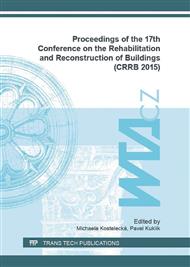[1]
De Bouw, M., I. Wouter S, J. Vereecken and L. Lauriks Iron and steel varieties in building industry between 1860 and 1914 – A complex and confusing situation resolved. Construction and Building Materials [online]. 2009, 23(8): 2775-2787 [cit. 2015-09-07]. DOI: 10. 1016/j. conbuildmat. 2009. 03. 009. Retrieved from: http: /linkinghub. elsevier. com/retrieve/pii/ S0950061809000890.
DOI: 10.1016/j.conbuildmat.2009.03.009
Google Scholar
[2]
ČSN 73 0038 (730038): Hodnocení a ověřování existujících konstrukcí - Doplňující ustanovení. 2014. Praha: Úřad pro technickou normalizaci, metrologii a státní zkušebnictví, (2014).
Google Scholar
[3]
Technické podmínky 42. TP 42 - Opravy, obnovy a přestavby ocel. nosných konstrukcí mostů: Metody a technol. k zvýšení zatížitelnosti a prodloužení životnosti. Praha: Pontex spol. s. r. o., (2014).
Google Scholar
[4]
Mccowan, C.N., T.A. Siewert, J.D. Mccolskey, K. Hildebrand and D.L. Olson N United States Capitol dome: Characterization of cast and wrought materials. Materials Characterization [online]. 2011, 62(8): 807-816 [cit. 2015-09-07]. DOI: 10. 1016/j. matchar. 2011. 05. 002. Retrieved from: http: /linkinghub. elsevier. com/retrieve/pii/S1044580311001094.
DOI: 10.1016/j.matchar.2011.05.002
Google Scholar
[5]
Gayle, M. a J. G. Waite. Metals in America's historic buildings: uses and preservation treatments. [2nd ed. ]. Washington, D.C.: U.S. Dept. of the Interior, National Park Service, Cultural Resources, Preservation Assistance, 1992, v, 167 p.
Google Scholar
[6]
Gordon, R. B. Process Deduced From Ironmaking Wastes and Artefacts. Journal of Archaeological Science [online]. 1997, 24(1): 9-18 [cit. 2015-09-07]. DOI: 10. 1006/jasc. 1995. 0092. Retrieved from: http: /linkinghub. elsevier. com/retrieve/pii/S0305440385700921.
DOI: 10.1006/jasc.1995.0092
Google Scholar
[7]
D'aniello, M., F. Portioli, L. Fiorino a R. Landolfo Experimental investigation on shear behaviour of riveted connections in steel structures. Engineering Structures [online]. 2011, 33(2): 516-531 [cit. 2015-09-11]. DOI: 10. 1016/j. engstruct. 2010. 11. 010. Retrieved from: http: /linkinghub. elsevier. com/retrieve/pii/S014102961000430X.
DOI: 10.1016/j.engstruct.2010.11.010
Google Scholar
[8]
Hlavní pravidla stavitelství: od Adolfa z Gabriely. Brno: Tisk a náklad Bušáka a Irrganga, 1861.
Google Scholar
[9]
Jondl, J. P J.P. Jondlovo Poučení o stavitelstvím pozemním: Třetí rozmnožené a opravené vydání. 3. Praha: I. L. Kober, 1874.
Google Scholar
[10]
ČSN ISO 13822: Zásady navrhování konstrukcí - Hodnocení existujících konstrukcí. Praha: Úřad pro technickou normalizaci, metrologii a státní zkušebnictví, (2015).
Google Scholar
[11]
Maraveas, C., Y.C. Wang A T. Swailes Fire resistance of 19th century fireproof flooring systems: A sensitivity analysis. Construction and Building Materials [online]. 2014, 55: 69-81 [cit. 2015-09-11]. DOI: 10. 1016/j. conbuildmat. 2014. 01. 022. Retrieved from: http: /linkinghub. elsevier. com/retrieve/pii/S0950061814000464.
DOI: 10.1016/j.conbuildmat.2014.01.022
Google Scholar
[12]
Collette, Quentin, Stéphane Sire, William J. Vermes, Vernon J. Mesler and Ine Wouters. Experimental investigations on hot-driven structural rivets in historical French and Belgian wrought-iron structures (1880s–1890s). Construction and Building Materials [online]. 2014, 54: 258-269 [cit. 2015-09-11]. DOI: 10. 1016/j. conbuildmat. 2013. 12. 059. Retrieved from: http: /linkinghub. elsevier. com/retrieve/pii/S0950061813012166.
DOI: 10.1016/j.conbuildmat.2013.12.059
Google Scholar
[13]
Pipinato, A., C. Pellegrino, O.S. Bursi and C. Modena High-cycle fatigue behavior of riveted connections for railway metal bridges. Journal of Constructional Steel Research [online]. 2009, 65(12): 2167-2175 [cit. 2015-09-11]. DOI: 10. 1016/j. jcsr. 2009. 06. 019. Retrieved from: http: /linkinghub. elsevier. com/retrieve/pii/S0143974X09001503.
DOI: 10.1016/j.jcsr.2009.06.019
Google Scholar
[14]
ČSN EN ISO 6892-1. Kovové materiály - Zkoušení tahem: Část 1: Zkušební metoda za pokojové teploty. Praha: Úřad pro technickou normalizaci, metrologii a státní zkušebnictví, (2010).
Google Scholar
[15]
ČSN EN 1990: Eurokód: Zásady navrhování konstrukcí. Praha: Český normalizační institut, (2004).
Google Scholar


